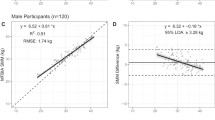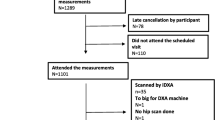Abstract
This report summarizes some preliminary absorptiometric (DXA, QCT/pQCT) studies from our laboratory, supporting the following assumptions. 1. InHomo sapiens at all ages, natural proportionality between DXA-assessed bone mineral mass (bone mineral content, BMC) and muscle mass (lean mass, LM) of the whole body or limbs is specific for ethnicity, gender, and reproductive status, but not for body weight, height, or body mass index. 2. This proportionality is sensitive to many kinds of endocrine-metabolic perturbations. 3. Percentilized or Z-scored charts of the BMC/LM correlations as determined in large samples of healthy individuals can provide a diagnostic reference for evaluating proportionality in different conditions. 4. Employing exclusively DXA, this methodology can be applied to discriminate between “disuse-related” and “metabolic” osteopenias based on the finding of normal or low BMC/LM percentiles or Z-scores respectively, with important therapeutic and monitoring implications.
Similar content being viewed by others
References
Martin R, Burr D, Sharkey N (1998) Skeletal Tissue Mechanics. Springer, New York
Ferretti JL (1998) Biomechanical properties of bone. In: Genant H, Guglielmi G, Jergas M (eds) Bone Densitometry and Osteoporosis. Springer, Berlin, pp 143–161
Kanis J (1994) Assessment of fracture risk and its application to screening for postmenopausal osteoporosis: synopsis of a WHO report. Osteoporosis Int 4:368–372
NIH Consensus Development Panel on Osteoporosis Prevention, Diagnosis, and Therapy (2001) JAMA 285:785–791
Ferretti JL, Frost HM (2002) Osteopenias and osteoporoses. Muscle-bone interactions, safety factors, and fracture risk. In: An Y (ed) Orthopaedic Issues in Osteoporosis. CRC, Boca Raton, pp 203–217
Ferretti JL, Cointry G, Capozza R (2002) Non-invasive analysis of bone mass, structure, and strength. In: An Y (ed) Orthopaedic Issues in Osteoporosis. CRC, Boca Raton, pp 45–67
Frost HM, Ferretti JL, Jee WSS (1998) Some roles of mechanical usage, muscle strength, and the mechanostat in skeletal physiology, disease, and research. Calcif Tissue Int 62:1–7
Frost HM (2004) The Utah Paradigm of Skeletal Physiology. ISMNI, Athens
Lanyon LE, Rubin CT, Raisz LE, Marotti G, Less H (1993) Osteocytes, strain detection, bone modeling and remodeling. Calcif Tissue Int 53(suppl 1):S102-S107
Mundy G (1995) Bone Remodeling and Its Disorders. Martin Dunitz, Surrey
Frost HM (1997) Defining osteopenias and osteoporoses. Another view (with insights from a new paradigm). Bone (NY) 20:385–389
Ferretti JL, Cointry G, Frost HM (2003) Body composition and osteoporosis. Mech Aging Dev 124:269–279
Cointry G, Capozza R, Negri A, Roldán E, Ferretti JL (2004) Biomechanical background for a noninvasive assessment of bone strength and muscle-bone interactions. J Musculoskel Neuron Interact 4:1–11
Marshall D, Johnell O, Wedel H (1996) Meta-analysis of how well measures of bone mineral density predict occurrences of osteoporotic fractures. Br Med J 312:1254–1258
Meunier P (1999) Evidence-based medicine and osteoporosis: a comparison of fracture risk reduction data from osteoporosis randomised trials. Int J Clin Pract 53:122–127
Vilani P, Bondino-R R, Bouvenot G (1998) Fragilité des données acquises de la science. Ľexemple du fluor dans ľosteoporose. Presse Med 27:361–364
Wilkin T (1999) Changing concepts in osteoporosis. Br Med J 318: 862–865
Ferretti JL (1997) Noninvasive assessment of bone architecture and biomechanical properties in animals and humans employing pQCT technology. J Jpn Soc Bone Morphom 7:115–125
Ferretti JL, Schiessl H, Frost HM (1998) On new opportunities for absorptiometry. J Clin Densitom 1:41–53
Ferretti JL, Cointry G, Capozza R, Zanchetta J (2002) Dual energy X-ray absorptiometry. In: Preedy V (ed) Skeletal Muscle: Pathology, Diagnosis, and Management of Disease. Greenwich, London, pp 451–458
Schneider P, Capozza R, Braun M, Reiners C, Ferretti JL (2001) Noninvasive (pQCT) assessment of bone quality and relative fracture risk at the distal radius in healthy and wrist-fractured individuals. Osteoporosis Int 12:639–646
Rho J, Kuhn-Spearing L, Zioupos P (1998) Mechanical properties and the hierarchical structure of bone. Med Eng Phys 20:92–102
Ferretti JL, Capozza R, Cointry G, García S, Plotkin H, Alvarez-F M, Zanchetta J (1998) Gender-related differences in the relationships between densitometric values of whole-body mineral content and lean mass in humans between 2 and 87 years of age. Bone 22:683–690
Ferretti JL, Capozza R, Cointry G, Capigioni R, Roldán E, Giménez C, Zanchetta J (2000) Densitometric and tomographic analyses of musculoskeletal interactions in humans. J Musculoskel Neuron Interact 1:18–21
Schneider P, Biko J, Reiners C, Demidchik Y, Drozd V, Capozza R, Cointry G, Ferretti JL (2004) Impact of parathyroid status and Ca and vitamin-D supplementation on bone mass and muscle-bone relationships in 208 Belarussian children after thyroidectomy because of thyroid carcinoma. Exp Clin Endocrinol Diabetes 112: 444–450
Augat P, Reeb H, Claes L (1996) Prediction of fracture load at different skeletal sites by geometrical properties of the cortical shell. J Bone Miner Res 11:1356–1362
Currey J (1999) The design of mineralized tissues for their mechanical functions. J Exp Biol 202:3285–3291
Hayes W, Piazza S, Zysser P (1991) Biomechanics of fracture risk prediction of the hip and spine by quantitative computed tomography. Radiol Clin N Am 29:1–18
Wainwright S, Biggs W, Currey J, Gossline J (1976) Mechanical Design in Organisms. Arnold, London
Ferretti JL, Capozza R, Zanchetta J (1996) Mechanical validation of a tomographic (pQCT) index for noninvasive estimation of rat femur bending strength. Bone 18:97–102
Capozza R, Cointry G, Cure-Ramirez P, Ferretti JL, Cure-Cure C (2004) A DXA study of muscle-bone relationships in the whole body and limbs of 2512 normal men and pre- and post-menopausal women. Bone 35:283–295
Ulla M, Stivala M, Ghiglione E, Noriega R, Cointry G, Ferretti JL (2001) Altered relationships between mineral and lean masses in obese, euglycemic, hyperinsulinemic women. J Bone Miner Res 16(S1):S402
Claus-H H, Fideleff H, Chervin A, Stalldecker G, Sinay I, Sobrado P, Cointry G, Ferretti JL (2001) Effects of GH on the mineral, lean, and fat masses in pan-hypopituitary men and women. J Bone Miner Res 16(S1):S403
Negri A, Cointry G, Salica D, Zanchetta J, Ferretti JL (2001) Bone/lean mass relationships in peritoneally-dialysed and haemodialysed men and women. J Bone Miner Res 16(S1):S544
Ferretti JL, Cointry G, Capozza R, Capiglioni R, Chiappe M (2001) Analysis of biomechanical effects on bone and on the muscle-bone interactions in small animal models. J Musculoskel Neuron Interact 1:263–274
Schiessl H, Ferretti JL, Tysarczyk-N G, Willnecker J (1996) Noninvasive bone strength index as analyzed by peripheral quantitative computed tomography. In: Schönau E (ed) Pediatric Osteology. Elsevier, Amsterdam, pp 141–145
Armitage P, Berry G (1994). Statistical Methods in Medical Research. Blackwell, London
Mazess R, Barden H, Bisek J, Hanson J (1990) Dual-energy X-ray absorptiometry for whole-body and regional bone-mineral and soft-tissue composition. Am J Clin Nutr 51:1106–1112
Bassey E, Rothwell M, Littlewood J, Pye W (1998) Pre- and postmenopausal women have different bone mineral density responses to the same high-impact exercise. J Bone Miner Res 13:1805–1813
Cheng S, Sipilä S, Taaffe D, Puolakka J, Suominen H (2002) Change in bone mass distribution induced by hormone replacement therapy and high-impact physical exercise in postmenopausal women. Bone 31:126–135
Järvinen T, Kannus P, Sievànen H (2003) Estrogen and bone: a reproductive and locomotive perspective. J Bone Miner Res 18: 1921–1931
Author information
Authors and Affiliations
Corresponding author
About this article
Cite this article
Cointry, G.R., Capozza, R.F., Ferretti, S.E. et al. Absorptiometric assessment of muscle-bone relationships in humans: reference, validation, and application studies. J Bone Miner Metab 23 (Suppl 1), 109–114 (2005). https://doi.org/10.1007/BF03026334
Issue Date:
DOI: https://doi.org/10.1007/BF03026334




